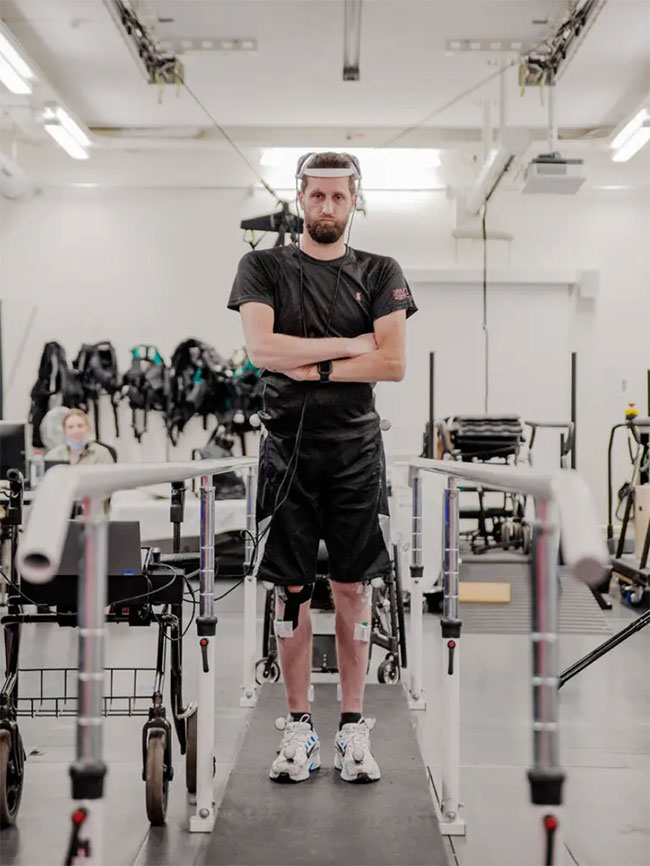Gert-Jan Oskam was living in China in 2011 when a motorcycle accident left him paralyzed from the waist down. Now, thanks to a combination of advanced devices, scientists have given this man the opportunity to move normally again.
Oskam said at a press conference on May 23, “For the past 12 years, I have always dreamed of being able to regain control of my legs. Now, I have learned how to walk normally, naturally.”
In a study published on May 24 in the journal Nature, researchers in Switzerland described an implant that provides a “digital bridge” between Oskam’s brain and spinal cord, bypassing the injured areas. This discovery allows Oskam, 40, to stand, walk, and climb slopes with the aid of a walker. More than a year after the implant, he has maintained these abilities and has shown signs of neural recovery, walking with crutches even after the implant device was turned off.

Gert-Jan Oskam. (Photo: The New York Times).
“We captured Gert-Jan’s thoughts and figured out how to convert these thoughts into impulses to the spinal cord to re-establish voluntary movement of the body,” said Grégoire Courtine, a spinal cord expert at the Swiss Federal Institute of Technology and the lead researcher, during the press conference.
There have been several advancements in spinal cord injury treatments in recent decades. In 2016, a team of scientists led by Dr. Courtine was able to restore walking abilities in paralyzed monkeys, and another group helped a man regain control of his paralyzed hand.
In 2018, another team of scientists, also led by Dr. Courtine, devised a method of brain stimulation using pulse generators, allowing partially paralyzed individuals to walk and cycle. Last year, more advanced brain stimulation procedures enabled paralyzed subjects to swim, walk, and cycle within a day of treatment.
Oskam had undergone stimulation procedures in previous years and even regained some walking ability, but ultimately, his health condition stalled his treatment progress.
Dr. Jackson added that scientists in this field have hypothesized about connecting the brain to spinal stimulation devices for decades, but this is the first time they have achieved such success in a patient. “It’s easy to talk about, but much harder to do,” said Dr. Jackson.
To achieve these results, experts implanted electrodes into Oskam’s skull and spine. The team then used machine learning to observe which parts of the brain lit up as he attempted to move different parts of his body. The thought decoder matched the activity of several electrodes with specific intentions when Oskam tried to move his ankle or hip.
Next, the scientists used another algorithm to connect the brain to the spinal cord, sending different signals to body parts to activate movement. Since signals were sent every 300 milliseconds, Oskam could quickly adjust his thoughts. Reportedly, during the first treatment session, Oskam was able to control his hip muscles.
In the following months, researchers refined the brain-spine interface to better suit basic actions like walking and standing. Oskam developed a seemingly healthy gait and could navigate stairs relatively easily, even after months without treatment. After a year, he began to notice clear improvements in his movement without the help of the brain-spine interface. Researchers documented these improvements in tests of weight-bearing, balance, and walking.
Now, Oskam can walk limited distances around his home, get in and out of cars, and stand at the bar to drink. This is very beneficial for his life as it makes him more independent and less reliant on others.
Researchers acknowledge some limitations in their work. They noted that the device struggles to distinguish more complex thoughts in the brain. While connecting the brain and spinal cord helps Oskam walk, the device may not be suitable for movements of the upper body. The implant is also an invasive medical procedure, requiring multiple surgeries and hours of physical therapy. The device does not cure all cases of spinal cord injury. The team hopes for improvements to make this technology more accessible and effective.
“This is our real goal,” Dr. Courtine said, “to provide this technology worldwide to all patients who need it.”
Gregoire Courtine, a neuroscientist at the École Polytechnique Fédérale de Lausanne in Switzerland and a co-author of the study, stated that this new advancement is “completely different” from previous achievements.
Speaking at a press conference in the city of Lausanne, Switzerland, he remarked, “Previous patients had to walk with a lot of effort, but now, they just need to think about walking to take a step.”
According to Guillaume Charvet, a researcher at CEA, “establishing the connection between the brain and spinal cord will promote the reorganization of neural networks” at the injury site.
The research team is currently exploring the potential application of this technology for rehabilitation in the arms and hands, and they hope it can be applied to treat other conditions such as paralysis from strokes.


















































